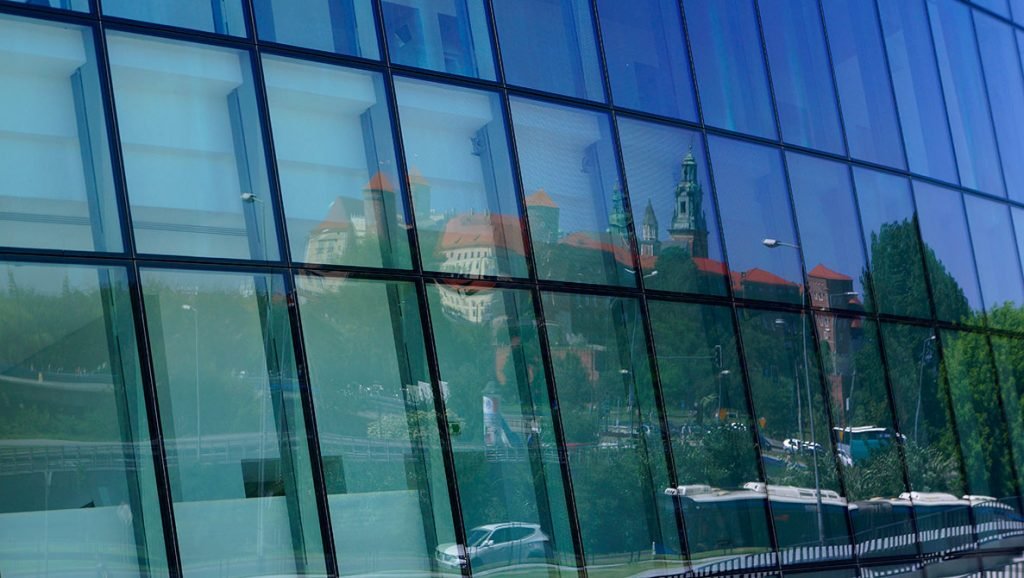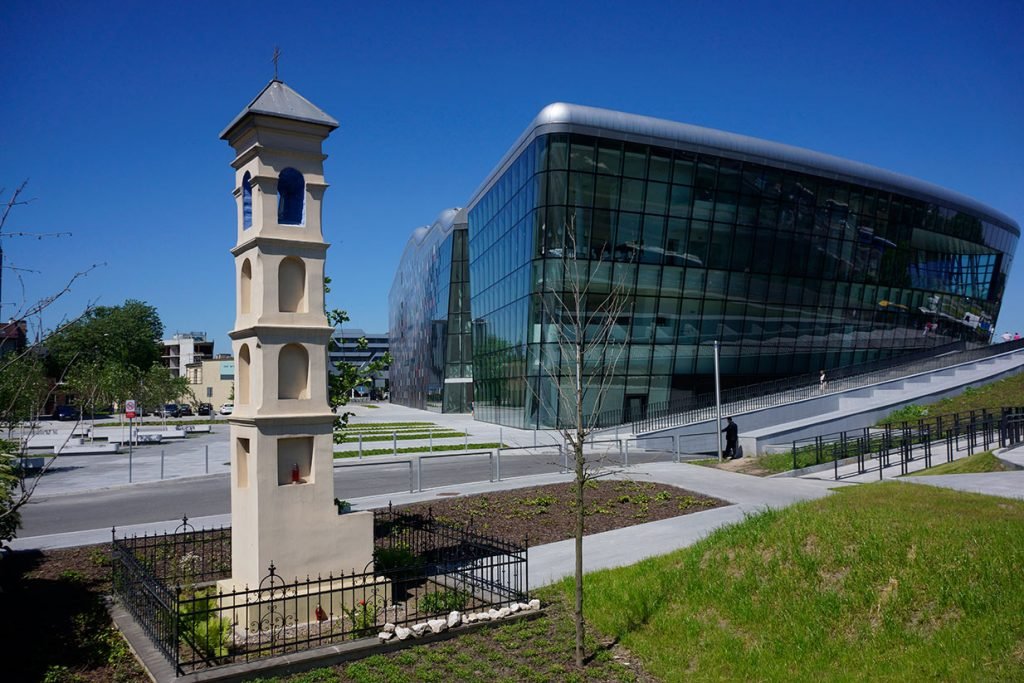Contrast
You may be surprised that we begin a course on the art of restoration with this set of pictures. You may be even more surprised that these are pictures from Kraków, a city so deeply rooted in history. In this course we want to explore an interconnection of the old and new and take you on a journey through various sites which encourage reflection on the value of historic objects in the colourful traffic of our times.
The modern building shown here is an excellent starting point for such explorations. Have a window view from its hall and see what comes through the glossy transparent surface. Click the photo to get a better picture.
These two buildings are highlights of the thriving city of Krakow – the Wawel Castle holding the most precious items of national culture and the ICE Centre hosting prestigious business and entertainment events. They coincide in one environment as counterpoints. Consider how the high-tech glazing is designed to invite the historic into the modern interior. Imagine the view the guests have while walking throughout the space. Through the glossy facade enjoy a view on a monument of the past.
Now let’s walk a little further from the conference and entertainment centre. Have a look at the wayside shrine in the picture on the right. How does it sit in the environment? Has it survived only by accident to continue solitary existence amidst alien objects? What does its rigid solemn shape communicate?
In this module we will pose more questions. Our objective is not to preach you on the value of things of the past. We rather want you to consider how they interact with contemporary developments and why it is perhaps wise to stop and think before we pass them.
Let’s begin with a question how to accommodate change in historic environments in a way that sustains their heritage values. This is a highly disputed issue with contrasting views on the appropriateness of modern insertions into historic urban areas. We enter a battle field here where conservationists are contesting advocates of modern developments. Change, however, is inevitable as such areas are usually living entities – still their unique character and value must be safeguarded.
The challenge of modernization is best reflected in a recent phenomenon of so-called starchitecture: new architectural monuments elevated at the very heart of historic cities. They are expected to secure global status for their cities as new icons – hence a label for these new developments: ‘iconic buildings’. These buildings contrast with traditional monuments through their spectacular design, grabbing attention and attracting visitors. They may include public buildings like museums, commercial venues like shopping malls or even private apartment buildings. Such buildings aim at originality through contrast which gives more spectacular effects than continuity in the already existing urban fabric of the historic city.
How to ensure that these developments don’t threaten the cultural identity of the historic settings which are unique due to their architectural and aesthetic quality? This challenge has been taken by the World Heritage Committee which organized an international conference in Vienna in 2005: “World Heritage and Contemporary Architecture – Managing the Historic Urban Landscape”. It is worth summarizing the key points of the closing Memorandum which express a wide consensus among the architectural community on what is considered appropriate in historic urban development.
- Architecture of quality in historic areas should give proper consideration to the given scales, particularly with reference to building volumes and heights.
- It is important for new development to minimize direct impacts on important historic elements, such as significant structures or archaeological deposits.
- Spatial structures in and around historic cities are to be enhanced through urban design and art as they are key elements of the renaissance of historic cities.
- Urban planning infrastructure in heritage zones must include all measures to respect the historic fabric, building stock and context.
- Townscapes, roofscapes, main visual axes, building plots and types are integral parts of the identity of the historic urban landscape and they serve as the basis for planning and design.
- As a general principle, proportion and design must fit into the particular type of historic pattern and architecture.
- Special care should be taken to ensure that the development of contemporary architecture is complementary to values of the historic urban landscape and remains within limits in order not to compromise the historic nature of the city.
With the above guidelines in view consider the following cases of contemporary architecture in three historic European cities:
Discuss the following questions with your tutor:
- How can a historic environment accommodate a variety of modern developments?
- Should each generation have the right to add new layers to the historic fabric of their places?
- Is this right limited in any way?
- Can you identify more examples of contemporary architecture in historic settings, both those you consider good and bad?
- What impact do these developments have within the existing environment?
- Have they enriched or rather diminished the special character of the historic place?



